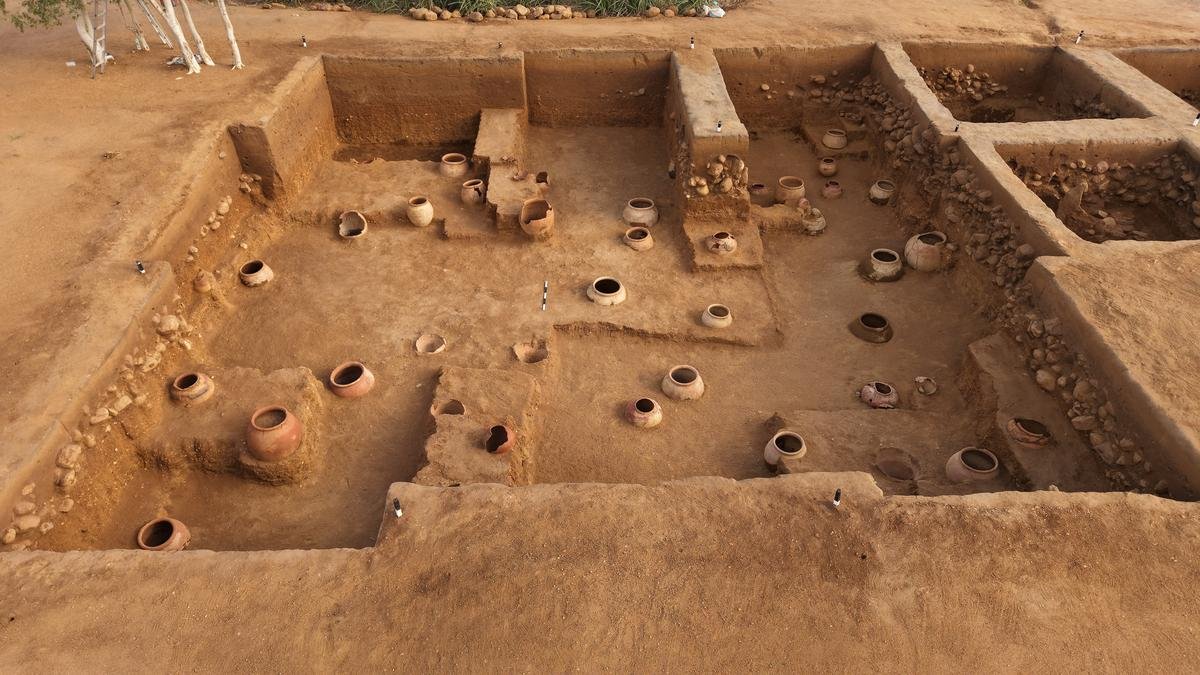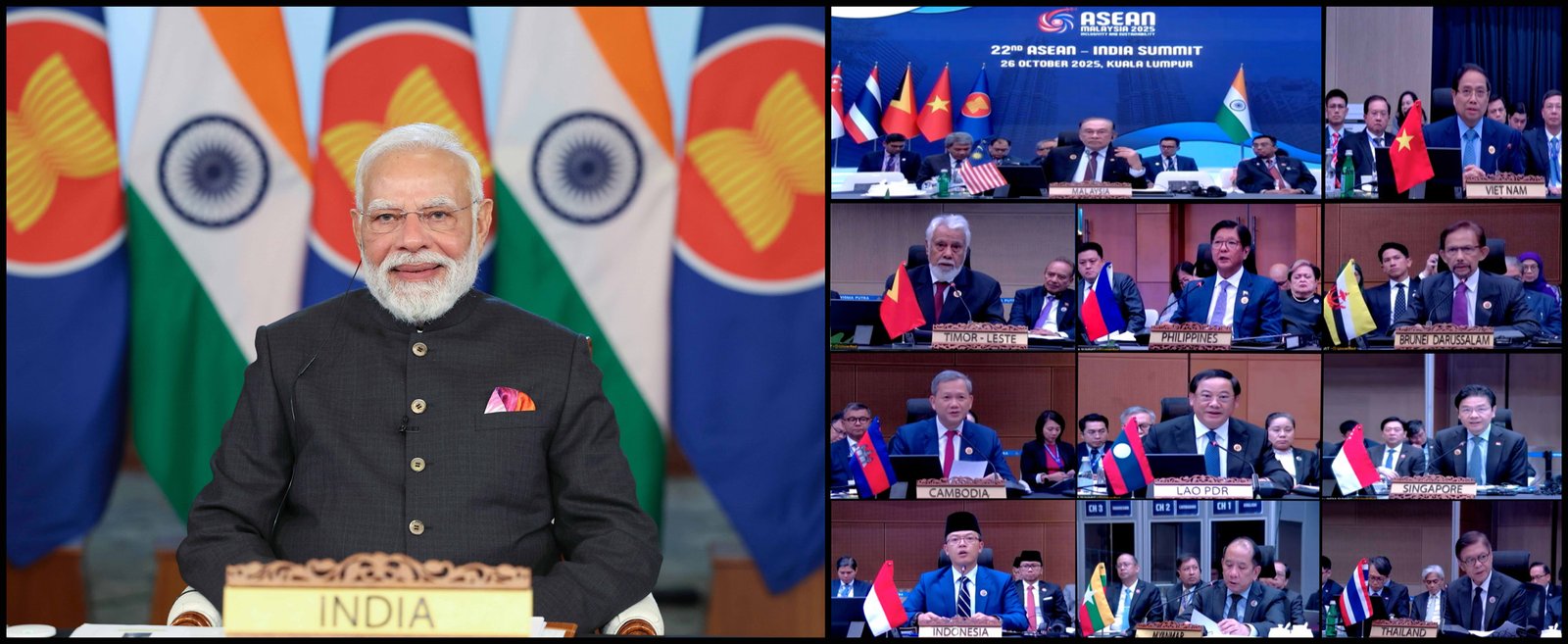Why in the News?
- The Tamil Nadu State Department of Archaeology (TNSDA) uncovered an extensive Iron-Age burial site at Thirumalapuram (Tenkasi district) during its first season of excavations.
- The excavation revealed a stone-slab urn chamber, diverse pottery types and metal artifacts, suggesting an early to mid-third millennium BCE occupation, pending scientific dating.
Key Highlights
- Discovery and fieldwork
- The TNSDA began systematic excavations at Thirumalapuram and opened 37 trenches across the site.
- The burial area covers roughly 35 acres, situated about 10 km northwest of the present village, between two seasonal streams originating in the Western Ghats.
- Major structural find: the stone-slab urn chamber
- Excavators uncovered a rectangular chamber built of 35 stone slabs, filled with cobbles up to 1.5 m deep.
- Inside the chamber were urn burials — pottery vessels containing human remains or grave goods — a first-of-its-kind discovery for Tamil Nadu.
- Urn burial: a funerary practice where the dead (or their ashes) are placed in pottery urns and buried; it is an important marker for certain prehistoric cultural phases.
- Pottery and grave goods: indicators of culture and chronology
- A wide assemblage of ceramics was found in graves and associated contexts: white-painted black-and-red ware (WP-BRW), red ware, red-slipped ware, black-polished ware, and coarse red ware.
- The presence of white-painted designs on black-and-red and black-slipped wares echoes similar decorative traditions reported at sites like Adichanallur and Korkai.
- Symbolic motifs and small finds
- Painted motifs on a red-slipped pot included dotted designs depicting a human figure, mountain, deer, and tortoise, hinting at symbolic or ritual language.
- A total of 78 small antiquities made of bone, gold, bronze and iron were recovered, including weapons (spearhead, dagger, arrowhead), tools (axe, chisel), a tweezer, and three tiny gold rings (each ~4.8 mm diameter).
- Dating and cultural placement (tentative)
- On the basis of artifact styles and parallels with sites such as Sivagalai and Adichanallur (which have dates ranging in the third millennium BCE), archaeologists tentatively place Thirumalapuram in the early to mid-third millennium BCE.
- Officials emphasise that scientific analyses (e.g., radiocarbon dating, thermoluminescence) are necessary to confirm the chronology.
Iron Age
1. What is the Iron Age?
- The Iron Age is the period in human history when iron became the main material for making tools, weapons, and implements.
- It marks a major technological and cultural shift after the Chalcolithic (Copper Age) and Bronze Age, when copper and bronze were mainly used.
- The use of iron allowed people to clear forests, cultivate more land, produce stronger weapons, and expand settlements; leading to significant social and economic changes.
2. Chronology of the Iron Age in India
- The Iron Age in India began around 1200 BCE to 1000 BCE, though it appeared earlier in some regions.
- It developed at different times in different areas:
- Ganga Valley (North India): Around 1200–1000 BCE (sites like Atranjikhera, Jakhera).
- South India (Tamil Nadu, Karnataka): Around 1000–600 BCE (sites like Adichanallur, Hallur, Maski, and now Thirumalapuram).
- Central and Eastern India: Around 800 BCE onwards (e.g., Chirand, Taradih).
- The period overlaps with the Later Vedic Age (1000–600 BCE) in northern India.
3. Key Features of the Iron Age
- Use of Iron Tools and Weapons:
- Iron replaced bronze for making axes, ploughshares, sickles, nails, spears, and swords.
- These tools helped in better agriculture, woodworking, and warfare.
- Agricultural Expansion:
- Stronger iron ploughs allowed people to cultivate heavier alluvial soils of the Gangetic plains.
- This increased food production and supported larger settlements.
- Urban Growth:
- Growth of permanent settlements and towns (e.g., Kausambi, Hastinapur).
- Iron-based economies supported craft production and trade networks.
- Social and Political Changes:
- Emergence of kingdoms and janapadas in northern India.
- Rise of new social hierarchies and specialised occupations.
- Burial and Cultural Practices:
- In South India, Megalithic burials (stone circles, urn burials, dolmens) are typical of this period.
- These graves often contain pottery, iron objects, beads, and ornaments, showing beliefs in life after death.
Important Iron Age Sites in India
| Region | Site | Significance |
| North India | Atranjikhera (UP) | Iron tools, pottery, early agriculture evidence |
| East India | Chirand (Bihar) | Iron implements with rice husks, showing settled agriculture |
| Central India | Eran (MP) | Iron weapons, beads, evidence of urban growth |
| South India | Adichanallur, Hallur, Maski, Thirumalapuram | Megalithic burials, urns, iron tools, and ornaments |
| Deccan Region | Takalghat and Mahurjhari (Maharashtra) | Iron objects and burial remains |
Key Terms
- Black-and-Red Ware (BRW) and White-Painted BRW
- BRW is a pottery tradition characterised by a black interior and red exterior produced by controlled firing and reduction-oxidation techniques.
- White-painted varieties show additional surface decoration applied post-firing and often indicate symbolic or regional stylistic choices.
- Manufacture involves specific clay selection, tempering agents and firing protocols that archaeologists can analyse to infer technology.
- Distribution patterns of BRW link inland and coastal trade networks in prehistoric South India.
- Petrographic and chemical analyses of ceramic paste reveal provenance and exchange mechanisms.
- Western Ghats — Archaeological Significance
- The Western Ghats plateau and foothills form an ecological and cultural corridor linking interior peninsular India with coastal zones.
- Seasonal streams and tank systems supported prehistoric settlements and farming communities; proximity to Thirumalapuram suggests resource advantages.
- Hill-plain interfaces often preserve unique settlement patterns and burial practices.
- Comparative studies across the Ghats frontier reveal patterns of mobility, resource exploitation and trade in prehistoric times.
- Conservation of such landscapes is crucial for protecting archaeological sites from modern development and erosion.
Implications
- Extension of Iron-Age presence: Thirumalapuram pushes evidence of early complex funerary customs closer to the Western Ghats, expanding our map of Iron-Age communities in south India.
- Cultural connections: Shared pottery styles and motifs suggest interaction networks among coastal and inland sites in southern India during the third millennium BCE.
- Funerary diversity: The stone-slab urn chamber indicates architectural investment in mortuary practice, revealing social attitudes toward death and memory.
- Material culture insights: Finds of iron, bronze and gold point to technological skills and craft specialisation, with implications for trade and resource use.
- Research priority: The site becomes vital for reconstructing regional prehistory, prompting further excavation, conservation and multidisciplinary scientific study.
Challenges and Way Forward
| Challenge | Way Forward |
| Uncertain chronology — stylistic dating is provisional. | Conduct radiocarbon dating of human bone/charcoal and thermoluminescence dating on pottery for absolute dates. |
| Site preservation — exposed trenches and fragile finds risk damage. | Implement immediate conservation, controlled backfilling, and a site management plan. |
| Contextual gaps — limited seasons so far hinder comprehensive interpretation. | Plan multi-season excavations, wider survey and geophysical prospection to map site extent and associated settlements. |
| Specialist analyses lacking — metallurgy, isotopes, and bioarchaeology pending. | Engage specialists: archaeometallurgy, palaeobotany, stable isotopes, and ancient DNA to reconstruct technology, diet and mobility. |
| Community engagement & heritage protection | Involve local stakeholders, create heritage awareness programmes, and legal protection to prevent looting or unregulated development. |
Conclusion
The Thirumalapuram excavations reveal a significant Iron-Age mortuary complex with distinctive urn burials, rich ceramics and varied metal artefacts. If scientific dating confirms the tentative early–mid third millennium BCE timeline, the site will be crucial to understanding southern India’s prehistoric networks, technology and ritual practices. Sustained multidisciplinary work and conservation are now essential.
| EnsureIAS Mains Question Q. Examine the archaeological significance of the Thirumalapuram burial complex in Tamil Nadu. How can multidisciplinary scientific analyses help resolve its chronology and socio-economic context? (250 Words) |
| EnsureIAS Prelims Question Q. With reference to the Thirumalapuram excavations, consider the following statements: 1. The discovery of a stone-slab rectangular chamber with urn burials at Thirumalapuram is the first such find in Tamil Nadu. 2. White-painted black-and-red ware (WP-BRW) is a diagnostic pottery type that can aid relative dating and cultural comparisons. 3. Radiocarbon dating of pottery is the primary method to obtain absolute dates for ceramic assemblages. 4. Presence of iron, bronze and gold objects at a site necessarily indicates continuous, uninterrupted occupation across multiple technological ages. Which of the statements given above are correct? Answer: B. 2 only Explanation: Statement 1 is Incorrect: The article states the stone-slab urn chamber is a first-of-its-kind discovery in Tamil Nadu, but this means this particular chamber type is newly reported at Thirumalapuram. It does not imply no other urn burials exist; other urn burial traditions (e.g., Adichanallur) are known. Precise phrasing matters. Statement 2 is Correct: White-painted black-and-red ware and similar pottery types have distinctive manufacturing and decoration traits. Such stylistic and technological markers are valuable for relative dating and establishing cultural links between sites when compared regionally. Statement 3 is Incorrect: Radiocarbon dating is applied to organic materials (charcoal, bone), not to pottery itself. Pottery can be dated by thermoluminescence (TL) or by dating associated organic remains; hence, C-14 of associated organics is typically used for absolute dating, not of the ceramic matrix directly. Statement 4 is Incorrect: Finding artifacts of iron, bronze and gold at a single site does not necessarily indicate uninterrupted occupation across separate technological ages. Metals can co-exist through trade, heirlooms, or reuse; contextual stratigraphy and dating are needed to interpret temporal sequences. |
Also Read | |
| UPSC Foundation Course | UPSC Daily Current Affairs |
| UPSC Monthly Magazine | CSAT Foundation Course |
| Free MCQs for UPSC Prelims | UPSC Test Series |
| ENSURE IAS NOTES | Our Booklist |





